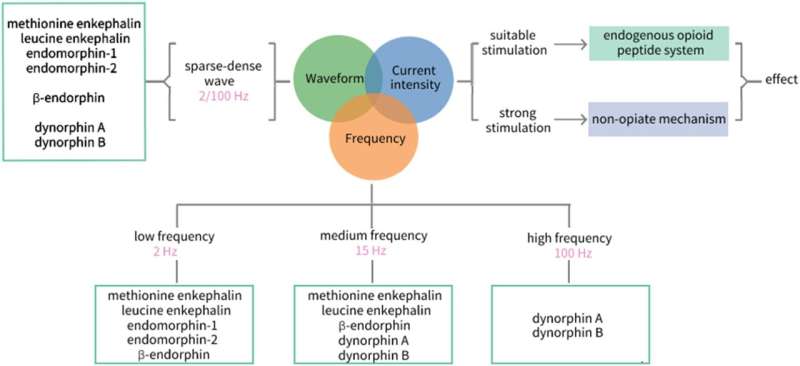This article has been reviewed according to Science X's editorial process and policies. Editors have highlighted the following attributes while ensuring the content's credibility:
fact-checked
proofread
Dose-effect relationship between electroacupuncture and the regulation of endogenous opioid peptide system

Endogenous opioid peptides are the neurochemical basis of the anesthetic and analgesic effects of acupuncture. The quantity of acupuncture stimulus can be controlled accurately by using electroacupuncture.
In a new study published in the World Journal of Acupuncture—Moxibustion, a team of researchers from China showed that that endogenous opioid peptides system presents a frequency-response specificity.
"The low frequency of electroacupuncture promotes the release of enkephalin, β-endorphin, and endomorphin, the high one activates the dynorphin system selectively, and the intermediate frequency works on promoting the release of enkephalin and β-endorphin, as well as dynorphin," explains Xue-song Tian, senior and corresponding author of the study. Tian is a professor at the Experiment Center for Science and Technology at the Shanghai University of Traditional Chinese Medicine.
"Sparse-dense wave of electroacupuncture may induce the release of enkephalin, β-endorphin, endomorphin, and dynorphin, presenting a synergistic effect," Tian further explains. "However, the waveform of electroacupuncture should be selected flexibly in clinical practice. Sometimes better therapeutic effect can also be obtained with the continuous wave of electroacupuncture."
Endogenous opioid peptides system has been found to be involved in mediating the appropriate intensity of electroacupuncture, while the acupuncture effect generated by an extra strong electroacupuncture stimulation refers to a type of stress response of non-opioid mechanism.
"The combination of electroacupuncture parameters should be optimized in accordance with different diseases, which is valuable for guiding clinical practice and the development of electroacupuncture therapy," says Tian. "Acupuncture is different from medication in terms of the mode of action, with more complicated and subtle regulatory effects involved."
The authors note that further quantitative studies of different stimulation parameters are needed to elucidate the underlying mechanisms of acupuncture further.
More information: Ping Chen et al, Dose-effect relationship between electroacupuncture with different parameters and the regulation of endogenous opioid peptide system, World Journal of Acupuncture - Moxibustion (2023). DOI: 10.1016/j.wjam.2023.06.003



















